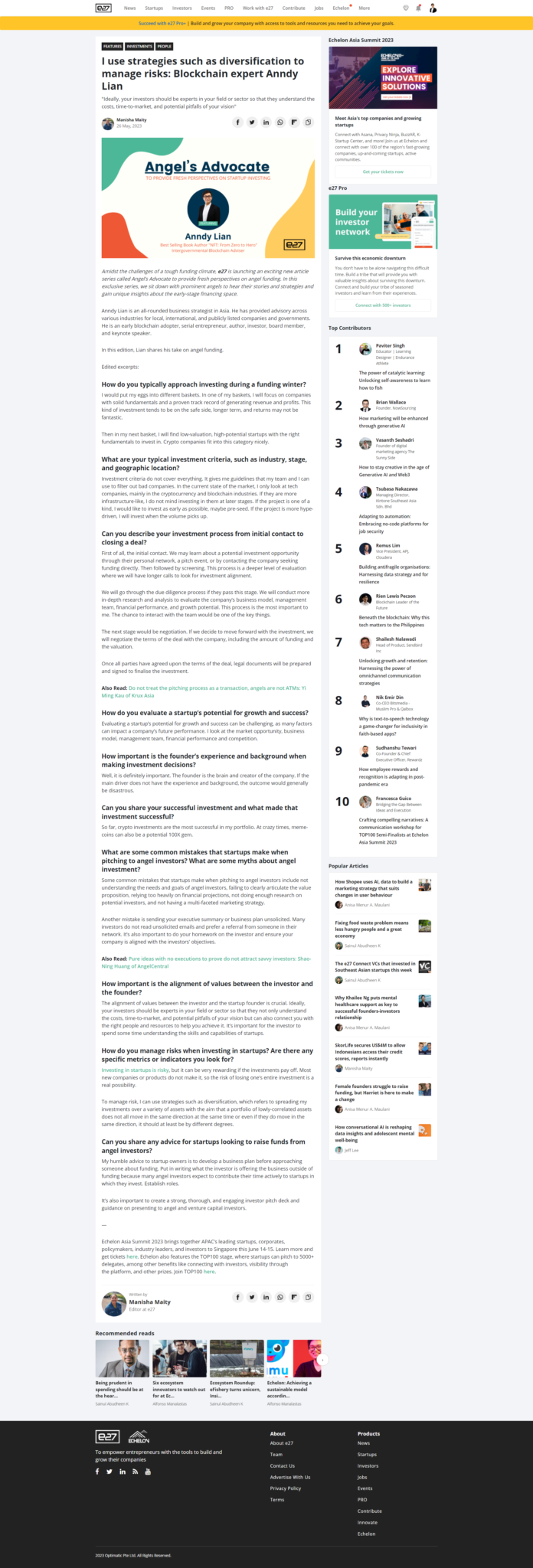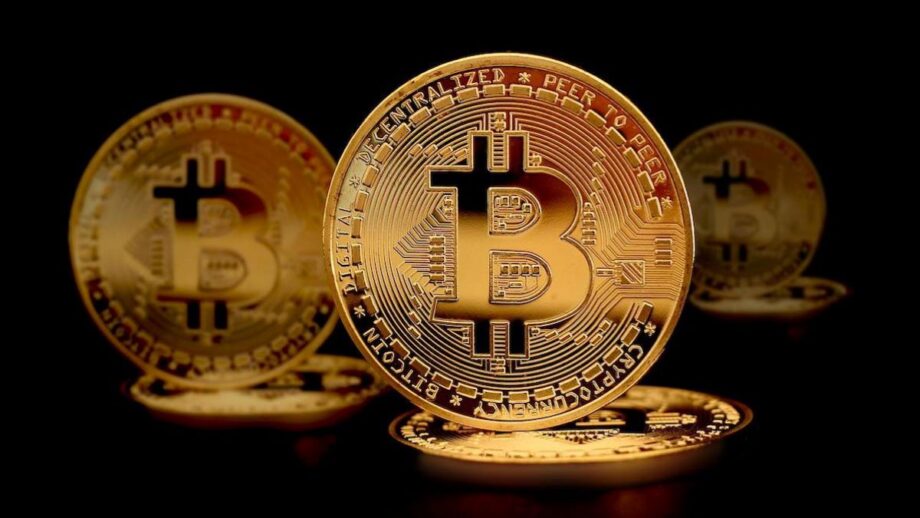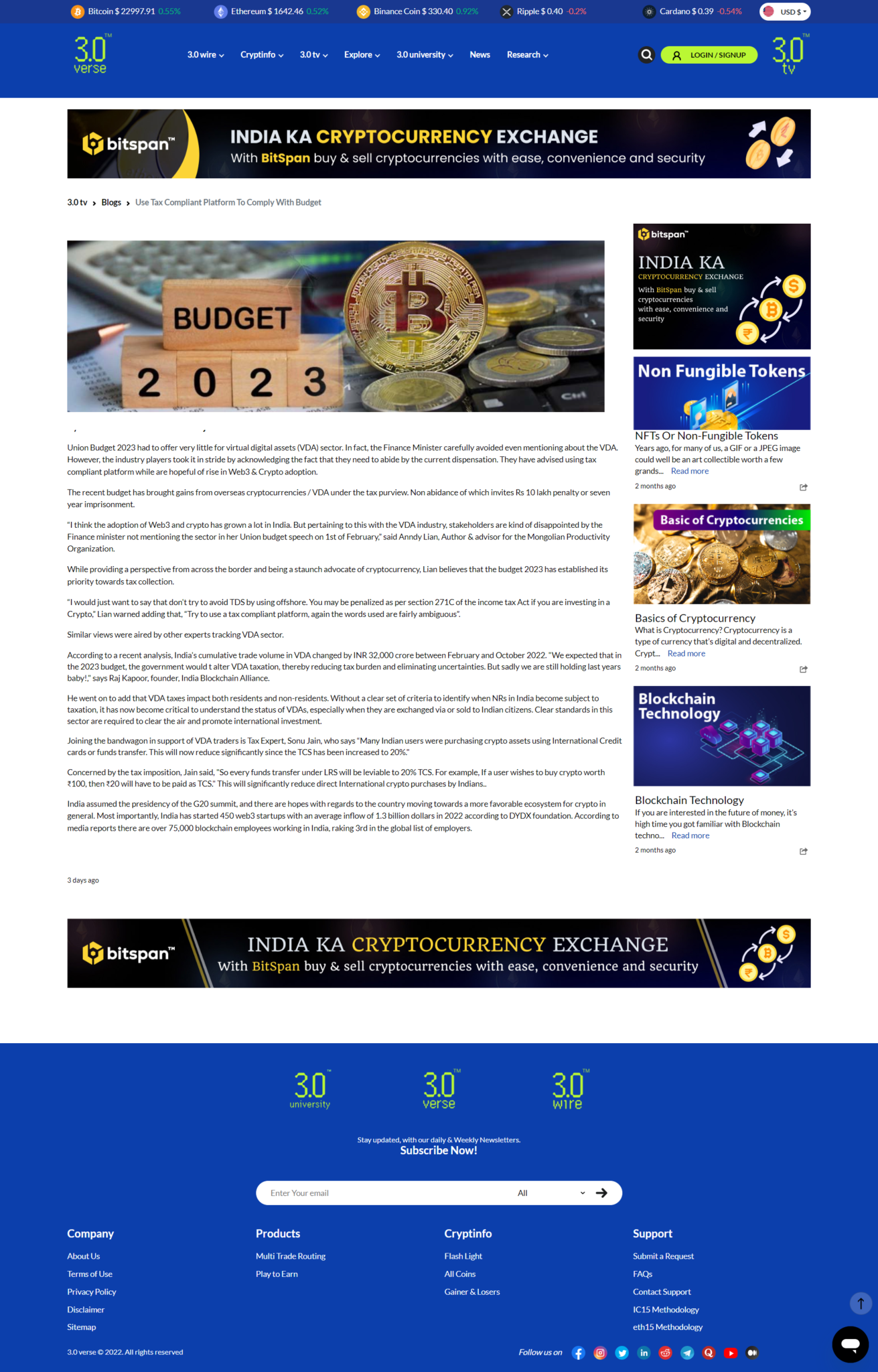Amidst the challenges of a tough funding climate, e27 is launching an exciting new article series called Angel’s Advocate to provide fresh perspectives on angel funding. In this exclusive series, we sit down with prominent angels to hear their stories and strategies and gain unique insights about the early-stage financing space.
Anndy Lian is an all-rounded business strategist in Asia. He has provided advisory across various industries for local, international, and publicly listed companies and governments. He is an early blockchain adopter, serial entrepreneur, author, investor, board member, and keynote speaker.
In this edition, Lian shares his take on angel funding.
Edited excerpts:
How do you typically approach investing during a funding winter?
I would put my eggs into different baskets. In one of my baskets, I will focus on companies with solid fundamentals and a proven track record of generating revenue and profits. This kind of investment tends to be on the safe side, longer term, and returns may not be fantastic.
Then in my next basket, I will find low-valuation, high-potential startups with the right fundamentals to invest in. Crypto companies fit into this category nicely.
What are your typical investment criteria, such as industry, stage, and geographic location?
Investment criteria do not cover everything. It gives me guidelines that my team and I can use to filter out bad companies. In the current state of the market, I only look at tech companies, mainly in the cryptocurrency and blockchain industries. If they are more infrastructure-like, I do not mind investing in them at later stages. If the project is one of a kind, I would like to invest as early as possible, maybe pre-seed. If the project is more hype-driven, I will invest when the volume picks up.
Can you describe your investment process from initial contact to closing a deal?
First of all, the initial contact. We may learn about a potential investment opportunity through their personal network, a pitch event, or by contacting the company seeking funding directly. Then followed by screening. This process is a deeper level of evaluation where we will have longer calls to look for investment alignment.
We will go through the due diligence process if they pass this stage. We will conduct more in-depth research and analysis to evaluate the company’s business model, management team, financial performance, and growth potential. This process is the most important to me. The chance to interact with the team would be one of the key things.
The next stage would be negotiation. If we decide to move forward with the investment, we will negotiate the terms of the deal with the company, including the amount of funding and the valuation.
Once all parties have agreed upon the terms of the deal, legal documents will be prepared and signed to finalise the investment.
How do you evaluate a startup’s potential for growth and success?
Evaluating a startup’s potential for growth and success can be challenging, as many factors can impact a company’s future performance. I look at the market opportunity, business model, management team, financial performance and competition.
How important is the founder’s experience and background when making investment decisions?
Well, it is definitely important. The founder is the brain and creator of the company. If the main driver does not have the experience and background, the outcome would generally be disastrous.
Can you share your successful investment and what made that investment successful?
So far, crypto investments are the most successful in my portfolio. At crazy times, meme-coins can also be a potential 100X gem.
What are some common mistakes that startups make when pitching to angel investors? What are some myths about angel investment?
Some common mistakes that startups make when pitching to angel investors include not understanding the needs and goals of angel investors, failing to clearly articulate the value proposition, relying too heavily on financial projections, not doing enough research on potential investors, and not having a multi-faceted marketing strategy.
Another mistake is sending your executive summary or business plan unsolicited. Many investors do not read unsolicited emails and prefer a referral from someone in their network. It’s also important to do your homework on the investor and ensure your company is aligned with the investors’ objectives.
How important is the alignment of values between the investor and the founder?
The alignment of values between the investor and the startup founder is crucial. Ideally, your investors should be experts in your field or sector so that they not only understand the costs, time-to-market, and potential pitfalls of your vision but can also connect you with the right people and resources to help you achieve it. It’s important for the investor to spend some time understanding the skills and capabilities of startups.
How do you manage risks when investing in startups? Are there any specific metrics or indicators you look for?
Investing in startups is risky, but it can be very rewarding if the investments pay off. Most new companies or products do not make it, so the risk of losing one’s entire investment is a real possibility.
To manage risk, I can use strategies such as diversification, which refers to spreading my investments over a variety of assets with the aim that a portfolio of lowly-correlated assets does not all move in the same direction at the same time or even if they do move in the same direction, it should at least be by different degrees.
Can you share any advice for startups looking to raise funds from angel investors?
My humble advice to startup owners is to develop a business plan before approaching someone about funding. Put in writing what the investor is offering the business outside of funding because many angel investors expect to contribute their time actively to startups in which they invest. Establish roles.
It’s also important to create a strong, thorough, and engaging investor pitch deck and guidance on presenting to angel and venture capital investors.


Anndy Lian is an early blockchain adopter and experienced serial entrepreneur who is known for his work in the government sector. He is a best selling book author- “NFT: From Zero to Hero” and “Blockchain Revolution 2030”.
Currently, he is appointed as the Chief Digital Advisor at Mongolia Productivity Organization, championing national digitization. Prior to his current appointments, he was the Chairman of BigONE Exchange, a global top 30 ranked crypto spot exchange and was also the Advisory Board Member for Hyundai DAC, the blockchain arm of South Korea’s largest car manufacturer Hyundai Motor Group. Lian played a pivotal role as the Blockchain Advisor for Asian Productivity Organisation (APO), an intergovernmental organization committed to improving productivity in the Asia-Pacific region.
An avid supporter of incubating start-ups, Anndy has also been a private investor for the past eight years. With a growth investment mindset, Anndy strategically demonstrates this in the companies he chooses to be involved with. He believes that what he is doing through blockchain technology currently will revolutionise and redefine traditional businesses. He also believes that the blockchain industry has to be “redecentralised”.




